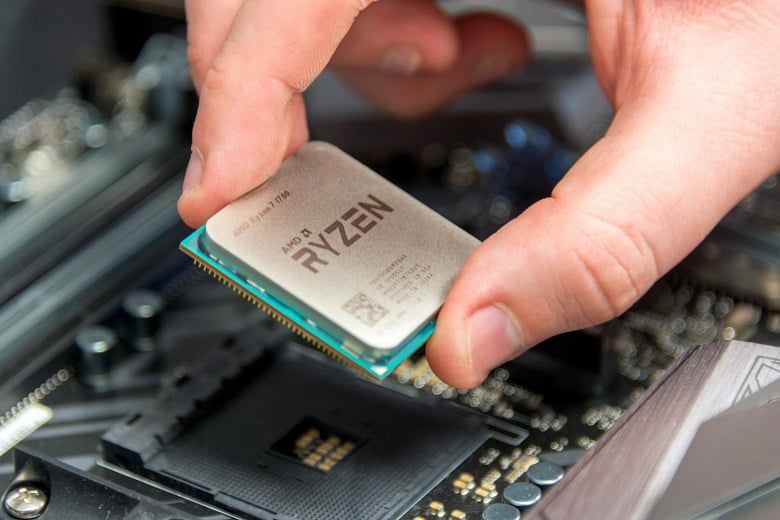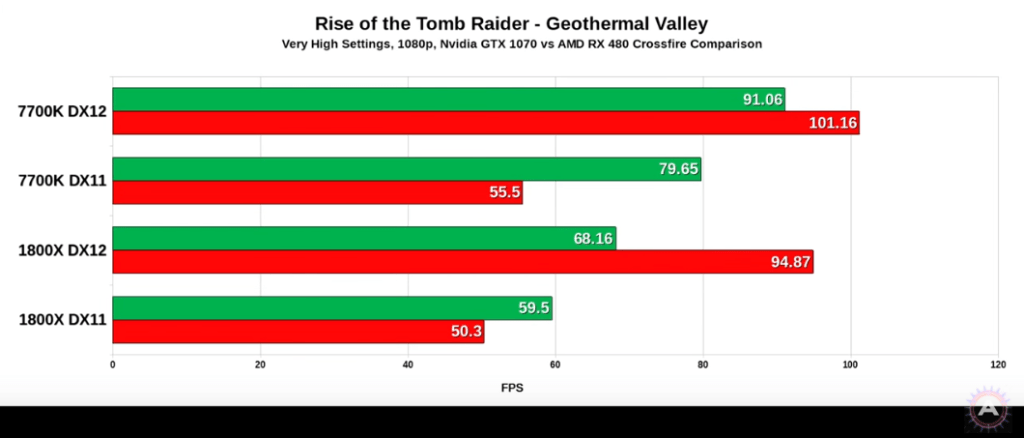AMD Ryzen held back by Nvidia Driver in Rise of the Tomb Raider under DX12?

AMD Ryzen processors offer an incredible performance in multithreaded applications, but they fall a bit short on the gaming side. Such is not all that surprising considering it’s is a brand new platform and there are still some rough edges to be ironed out over time.
The good news is the first optimizations for Ryzen have already begun to arrive, starting with Oxide Games’ Ashes of the Singularity: Escalation. Additionally, AMD is readying to push a new AGESA update to its motherboard partners that will help gamers to squeeze more performance out of their Ryzen PCs.
That being said, it seems that there is something more to the disappointing gaming performance by Ryzen CPUs. According to a new video from AdoredTV, there might be something wrong with AMD Ryzen game tests in general.
The video identifies a possible problem in Nvidia driver that causes graphics cards to work poorly with Ryzen chips. This is at least true for DX12 path of Rise of the Tomb Raider.
The Inbuilt benchmark comprises of three stages. The first stage is the Mountain Pass where the game begins, the second is Syria which is right after the start of the game, and then the third phase is the Geothermal Valley which is a little bit later on the game.
As seen in benchmarks from different sites, the flagship Ryzen 7 1800X delivered an inferior performance than an Intel Core i7 7700K. The press widely used Nvidia cards for benchmarking and it was completely understandable because AMD didn’t release any high-end graphics card last year.
Read More: AMD’s rumored 16-core Ryzen CPU may run at 3.1GHz base and 3.6GHz boost clock
AdoredTV decided to benchmark the Ryzen 7 1800X against the Core i7-7700K in Rise of the Tomb Raider, and did so with an overclocked GeForce GTX 1070 as well as Radeon RX 480 Crossfire.
As it turns out, the Ryzen 7 1800X outputs better DirectX 12 results in the benchmarks when using the RX 480 Crossfire than a GeForce GTX 1070 OC. The chip doesn’t surpass the Kaby Lake flagship, but it does approach the i7 7700 levels of performance and even matches in some scenarios.
Surprisingly, the 1800X was four frames ahead of the 7700K with the GTX 1070 when both were running DX11 in Mountain Pass. The Ryzen chip, however, looks like a disaster under DX12.

When using an RX 480 Crossfire, the Ryzen 7 1800X goes from 64 fps to 113.1 fps almost tying in with a 7700K which has also jumped from 101 fps to 113.5 fps. The DX11 results have taken a bit of a tumble but that’s something we’re already aware of which happens thanks to CPU overhead.

The GTX 1070 Syria results are not much different from the Mountain Pass: under DX12, the 1800X is a long behind the 7700K. When switched to the RX 480s, the i7-7700K again sees a boost in performance, but Ryzen’s DX12 gain is absolutely massive.

With Radeon GPUs, the AMD chip jumps from 91.73 fps to 129.47 fps and the difference shrinks from 25% to 11%. Even under DX11, the 1800X gains respectable frame rates but that’s probably because of the RX 480s as the setup is faster than the GTX 1070 OC.

Moving to Geothermal Valley, the i7-7700K has 33.5% lead over the 1800X using an Nvidia graphics card, and when switched over to AMD graphics card, the gap is now down to 6.6%. Moreover, in both DX11 and DX12, both CPUs gain performance.

So the problem is not related to AMD Ryzen but Nvidia DX12 drivers which are apparently not doing the job as they are meant to be. The results show that this isn’t a CPU bottleneck but an API bottleneck as DX11 is simply unable to break up that thread but DX12 can.
In the case of Rise of the Tomb Raider, it is only the AMD’s DX12 driver which is capable of breaking up the main thread. Nvidia’s driver does work, but it’s not anywhere near AMD’s. That is the true performance of CPUs when there is no driver overhead.
Moreover, Rise of the Tomb Raider is a GameWorks title running Crossfire so there is no chance that Ryzen is optimized here. The DX12 is just working out of the box with AMD and it’s doing everything that it is meant to do.
To conclude, Nvidia driver isn’t capable of breaking up the threads as efficiently and thus unable to extract the full performance out of the AMD Ryzen CPUs. With Vega coming out in a few weeks, it makes sense for AMD to optimize their hardware to work best with their next-gen GPUs. But for now, the results are quite hopeful.
DON’T MISS: Intel’s Core i7 7740K struggles against Ryzen 5 1600 in SiSoft benchmark



![AMD Stock May Continue to Rise [Post-Stadia Update]](https://digiworthy.com/wp-content/uploads/2019/03/Google-Stadia-768x512.jpg)


